That’s Amari - Exploring the Wonderful World of Amari as we travel across Italy & ICYMI - Great reads worth reading
Issue No. 16 - We suffer so you don’t have - creating an amaro-based cocktail poolside in Italy, exploring the wonderful world of amari, and helping you be the most interesting guest at the party!
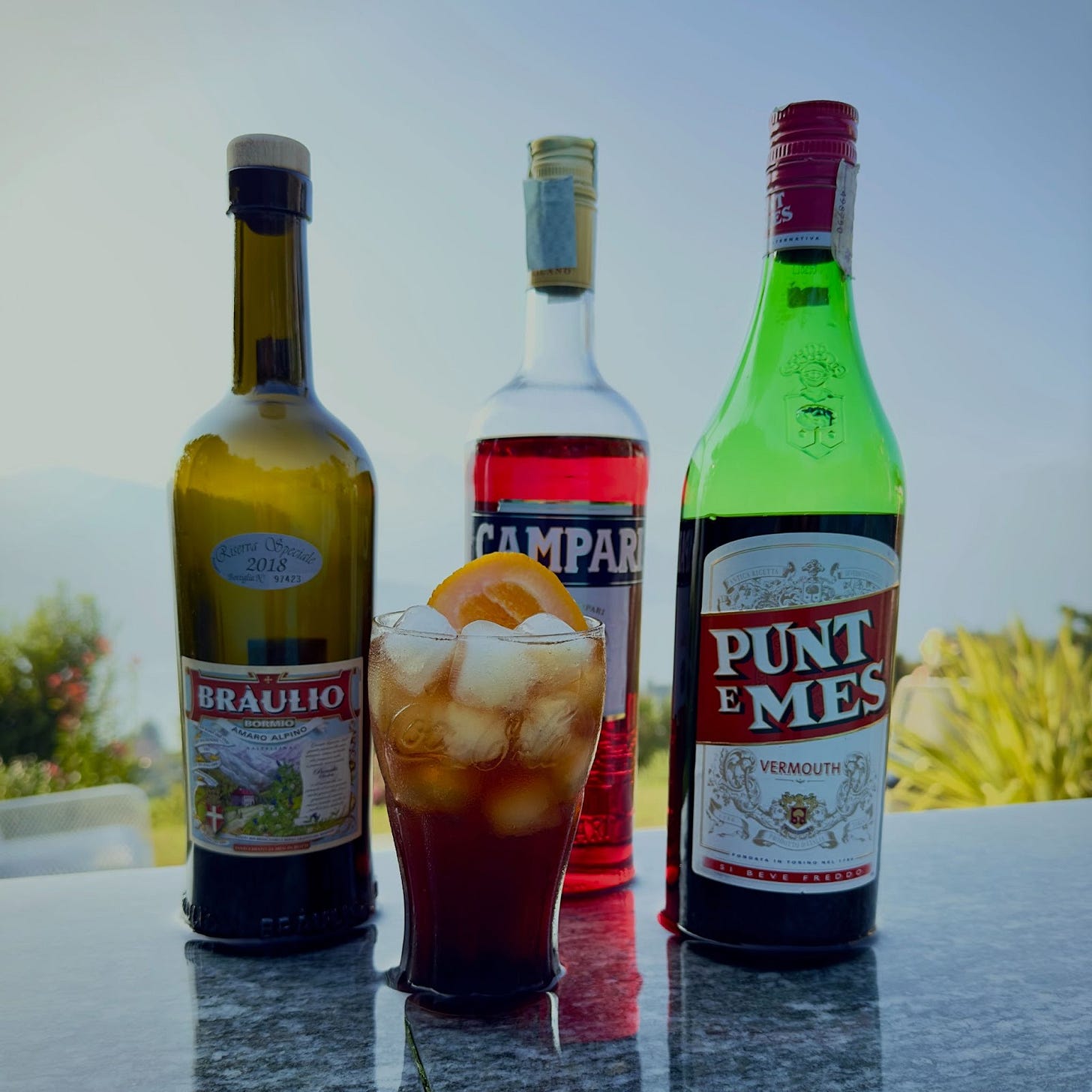
Apologies for the C&C drought the last few weeks. After the last big issue on the Hanky Panky and The Unbearable Lightness of MQs and Waves, I promptly boarded a plane for Europe the same day for an extended “workation”. OK, OK, it was mostly vacation, but in this issue I hope you can benefit from at least part of the trip… a veritable buddy-movie road trip Bill and I took to explore the wonderful world of amari in Italy - and of course we managed to invent a cocktail or two along the way as well.
Paired with that are some great reads we consumed during the long and wonderful train rides, road trips, and recovery from the many miles of walking and hiking in Rome, Cinque Terra, Florence, Turin, Verona, Bergamo, and Lake Como. My hope is these reads will help you be the most informed and interesting guest at the cocktail party as you anxiously await our next analysis issue. Thanks for reading and I hope you enjoy it! Cheers!
This Week - The Braucano and the wild and wonderful world of amari
Frequent readers of the newsletter will no doubt recognize that we have focused a lot on amari - the plural of ‘amaro’ - and used a number of them in the cocktails we have featured here. When we first started exploring amari fifteen years ago, few were available in the US or outside of Europe. But over the last decade, the availability of different amari outside of Europe has exploded - now there are dozens you will see regularly in the U.S., and some quality makers in North American and across the world as well.
One key reason is the growth and expansion of interest in mixology and cocktail culture, as amari make such great tools in the hands of talented bartenders and enthusiasts in the creation of a wide spectrum of cocktails - adding bitter, sweet, and spice to the palette in a tidy package - with booze! Amari are flavor packed, with many dozens of ingredients each, making them incredible ‘spice mixes’ for the mixologist. (If you are new here, explore our back issues for more on various amari.)
‘Amaro’ literally means ‘bitter’ in Italian, and the category covers a wide range of aperitifs and digestifs found in Italy and across the whole of Europe. For those less familiar, aperitifs are meant for before dinner - such as sipping away the afternoon as you play cards in the piazza with your special someone (as pictured below) - whereas digestifs are for after dinner to help you settle your stomach and wind down your day.
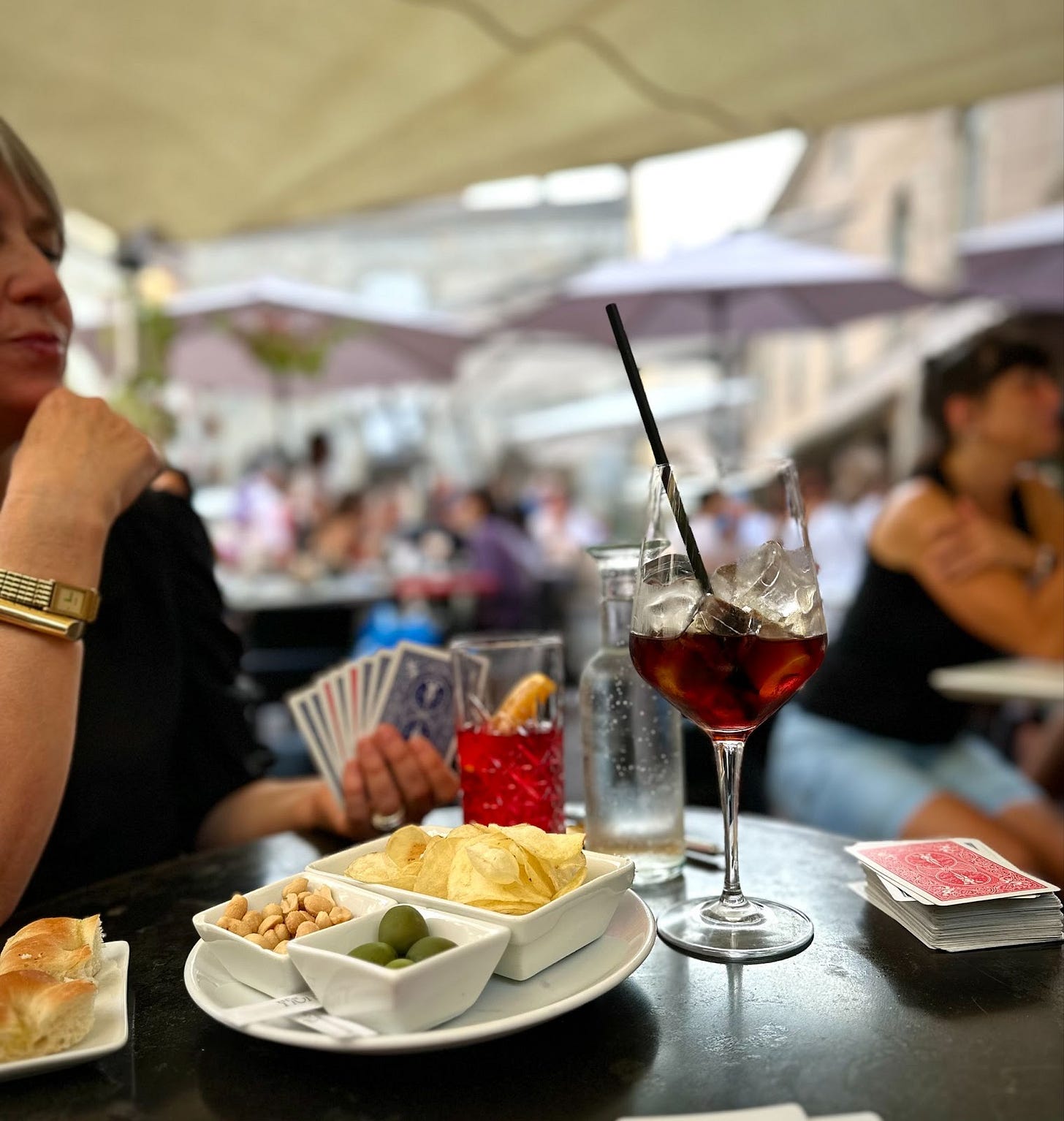
There is some science to it, seriously.
Human beings typically have around twenty-five different bitter taste receptors (known as T2Rs), which is significantly more than the one we have for sweet, and the one for umami. For you biology nerds - sour, in contrast, is detected by ion channel receptors using a somewhat different biochemical mechanism - one that I am choosing not to explore because, well, I am not a scientist… I am a mixologist!
Most scientists reason that the large number of bitter taste receptors reflects the fact that many toxic compounds found in nature are in-fact bitter, and thus a large number and diversity of bitter taste receptors allows humans - and other animals - to detect a wide range of bitter-tasting compounds to keep us safe. (This one is good… whoops!)
Beyond taste though, our bodies physiologically react to bitter flavors by stimulating the digestive tract. If you are going to eat something potentially poisonous, may as well evacuate it quickly! (Think this about the next time your morning coffee has you scurrying to the bathroom to drop the kids off at the pool before work - there is a reason!)
Across Europe, these amari typically originated in the 19th century as medicine. Recipes often originated in monasteries or pharmacies - in Italy these are known as Erboristerias - as a way to pack medicinal herbs and substances into tidy, little packages easy to consume, distribute, and have on-hand - since they could stay shelf stable. And, thus bitter aperitifs and digestifs have a legitimate claim as a component of a healthy diet - stimulating the digestive system before and after a large meal. (I rest my case! I drink for health!)
A little of this, a little of that - and then some sugar
Amari are typically produced by macerating a combination of herbs, roots, flowers, bark, and citrus peels in alcohol - either with neutral spirits or wine. After maceration, sugar is typically added - which can actually impart a lot of flavor itself - depending on the type of sugar used and if it has been caramelized to varying degrees. Amari without sugar are an acquired taste, like the the Cappalletti Rutaben we tasted when we visited Cappaelletti Distilery in Aldeno, Italy just south of Trento in the foothills of the Italian Alps. (It packed a bitter, herbaceous wallop! And we each bought a bottle… or two!)
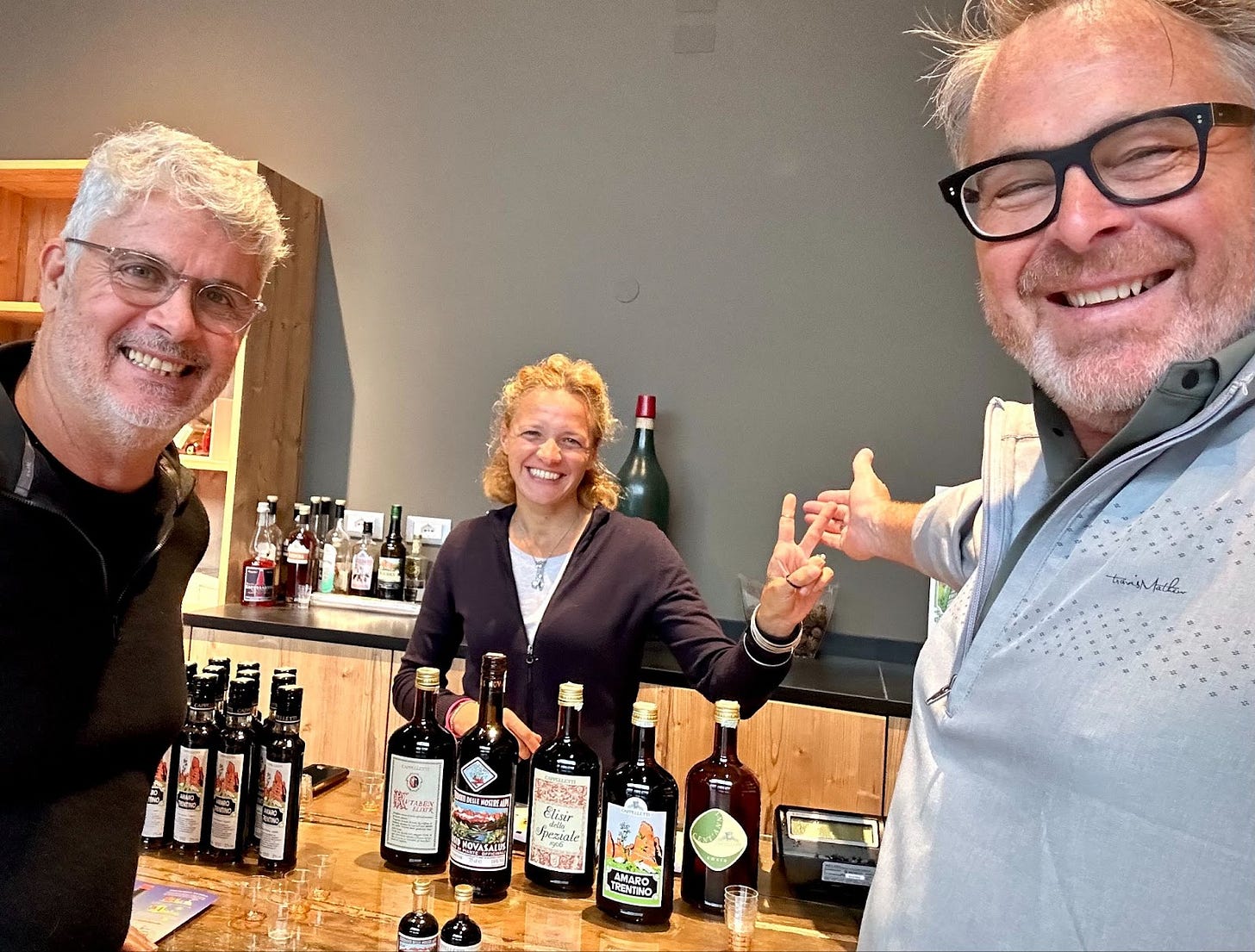
Many amari are aged in casks or bottles, though not all - some are essentially ready after macerating for only a few days or weeks. Recently more and more amari makers are putting away bottles to age, such as the Brualio Reserve I feature in the Braucano (pictured at the top, with the recipe below).
Amari may be Italian, but there are bitters (booze and people) the world over.
Most will probably be familiar with a handful of amari found in most bars and restaurants in the U.S., Europe, and the rest of the world - such as Averna, Campari, Fernet-Branca, Ramazzotti, Amaro Montenegro, and Amaro Nonino - which is why we have featured many of them - we know you can find them relatively easily. (I will not mention Aperol, because… Fuck Aperol! Shit...)
But the world of amari stretches far beyond these commonly found bottles and far beyond Italy. You can find very similar elixers across much of the Europe - such as in France where they are called ‘amer’, with examples like Salers, Suze, and Amer Picon. In Germany they are known by the lovely moniker kräuterlikör and represented by such venerable examples as Underberg and Jägermeister - so yes, the frat boys like amari, who knew. This also extends across nearly the whole of Europe - from Slovakia, Hungary, the Netherlands, and many, many others. In many places, people still make these for their villages or families and friends. You can find them at farmers’ markets - and even pharmacies still today - with a small, but welcome, burgeoning resurgence in artisanal methods and recipes.
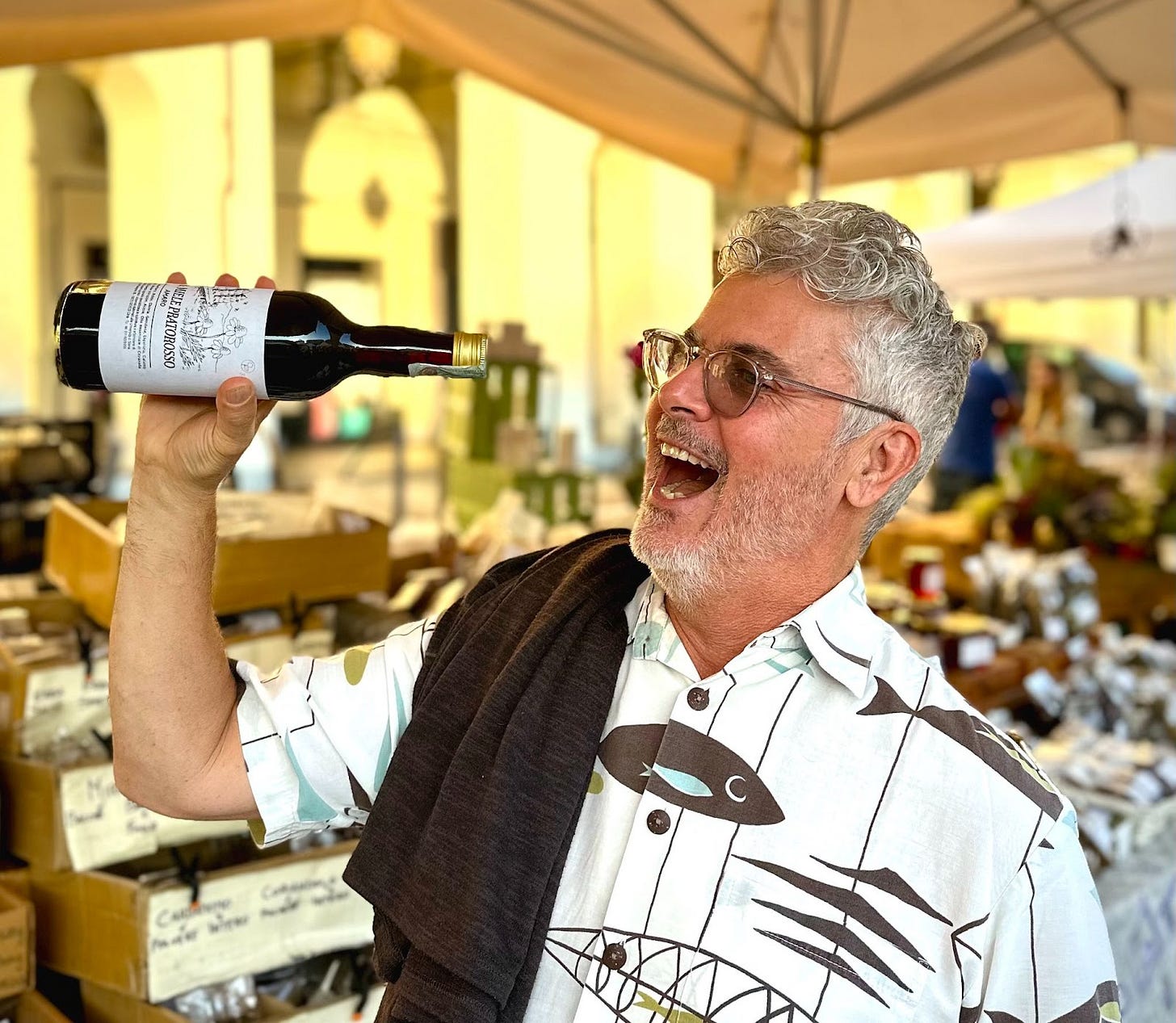
There are many high quality makers in the U.S. now doing good work as well, such as Seattle’s Fast Penny Spirits and Sennza Finne, New York’s Faccia Bruto, or Washington D.C.’s Don Ciccio & Figli - to name just a few. If you are in the U.S., I encourage you to support them and try their products as well. The quality and distribution are improving rapidly.
The special shit you can’t find without going there - the legend of San Simone.
Despite how prevalent and popular these are, many amari never actually make it out of their home country or region - either because the producers enjoy producing at a smaller scale, lack access to some of the more uncommon ingredients in order to scale up, or because everyone in town drinks as much as they can produce! That seems to be the case with San Simone. You simply can’t find San Simone easily outside of Torino and the Piedmont region. Which is why we had to travel there to taste it!
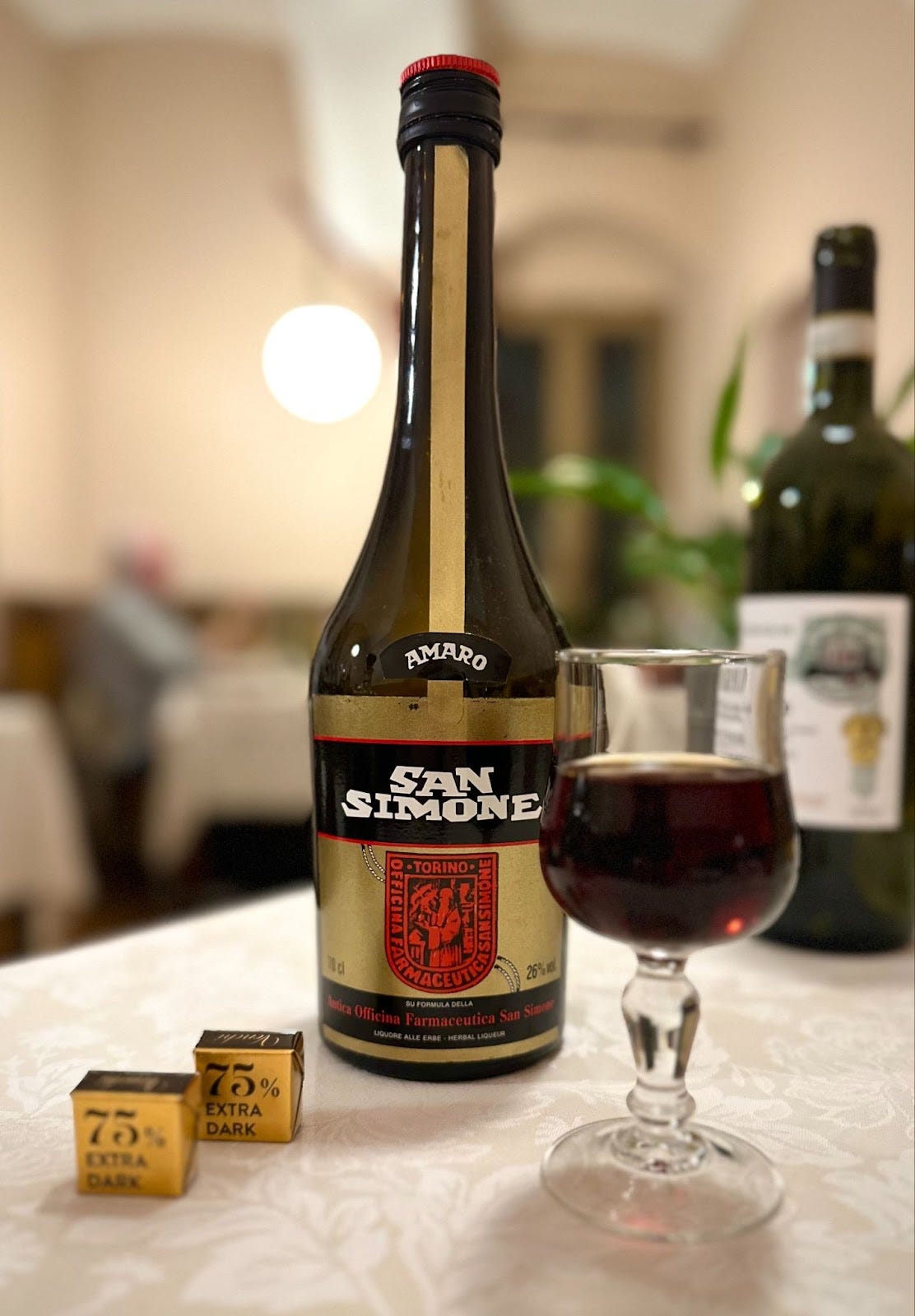
After a long haul from Verona to Torino (aka: Turin), we finally got to sample this legendary elixir after a spectacular Piedmontese meal - vitello tonnato, an amazing fresh ricotta salad, fresh anchovies, roasted meats - that left us full and satiated. We had already noticed nearly every table around us ordering San Simone as they finished their meals - a smart set of locals who clearly knew what they were doing. Some ordered it with coffee on the side and we could hear them hum with delight as they alternately sipped their espressos and San Simone as we waited patiently in anticipation.
San Simone has a long history. It is a descendant of a recipe dating back to the sixteenth century, first created by a brotherhood of monks from Torino to improve blood circulation - the ‘Depurative San Simone’. The Romanesque church of Santi Simone e Giuda near via Garibaldi in Torino was demolished in the eighteenth century, but the amaro was produced and distributed by the Antica Officina Farmaceutica San Simone until the 1950s. It was at that point that some felt that the recipe could use an update - albeit one that adhered to the key ingredients, principles and profile of the original. Thus it was that in 1960 the pharmacist Aldo Fechino, founder of the current Amaro San Simone, arrived at the current formula after years of experimentation and refinement. Soon after, consuming San Simone for pleasure shifted its distribution as a digestive drug to a commercial liqueur, embraced by Torino’s many fabulous cafés and restaurants.
The company still operates in the same factory as then, maintaining it’s craftsmanship in the production of the liqueur despite the death of Doctor Fechino in 2012. Today San Simone - with its thirty-four secret medicinal herbs and sugar has deservedly become “The Pride of Turin” - just good luck finding it without a trip to Piedmont. In a world dominated by consumerism, mass marketing, and mass production, it is somehow heartwarming that San Simone’s success has been built on the fact that, until recently, it has been established, celebrated and consumed only in Torino.
When we finally tasted it, it did not disappoint. Cinnamon, nutmeg, and bitter - yet well balanced. They had brought some dark chocolate to the table with it, which we at first had ignored. But once we grew curious and took a bite of the bitter chocolate and then a sip of San Simone we were floored. Amazing, and it explained the coffee the others had paired with it to their delight as well. Before we left the table we each added six bottles to our carts from our source in Rome we had bought from before - they actually had it!
So why mix with amari?
In Italy and across Europe, amari typically have an alcohol content between 16% and 40% and are typically drunk neat, sometimes with a citrus wedge, but may also be put over ice - or with tonic or mineral water ‘con gas’. Many amari will even change their flavor profile dramatically when you play with dilution and temperature. I love Ramazotti over ice, for example, but not so much neat - so if you think you don’t like one, try it another way and you very well may.
For the mixologist, these delightful bottles-of-wonder also enable you to pack in flavors in a low-ABV package, or alternatively skip the juice and other modifiers and head the other way with your mixing - boozy! In some ways, for the mixologist these are like the amazing, foundational spice mixes chef’s and home cooks alike rely on the world over - from curries to Ras El Hanout to Herbes de Provence - to aid in their gastronomic creations.
A Braucano erupts poolside at Lago di Como
One example of a classic Italian amaro focused aperitif is the Americano cocktail - not to be confused of course with a coffee Café Americano. The Americano is equal parts Campari and sweet vermouth, often topped with sparkling mineral water and garnished with a slice of orange. It is a delightful low-ABV cocktail that could not be simpler or faster to make. It is essentially a Negroni absent the kick and herbaceous notes from gin - or the punch and sweetness of the bourbon in a Boulevardier.
Poolside at a rented villa above Lake Como, I was working (really!) into the late afternoon (OK, OK… I had only just sat down to work) when I decided a little low-ABV action might temper the six espressos I had had that morning. And when investigating the spirits supply in the villa, boom… Braulio Reserve Speciale! And Punt e Mes! (I’m giving this place 5-stars, who gives a shit about the infinity pool!) I grabbed the bottle of Campari my wife and I had bought from the local grocer/baker/salumi guy and went to town. (Sorry, bad analogy: I stayed at the villa - I had already been to town.)
The results were like tossing a sprig of mint and coffee and chocolate in an Americano. In other words, awesome - and just another example of how mixing with amaro can lead to unexpected deliciousness.
To be clear, my little riff on the Amerciano is just a simple example of subtle experimentation, and one I would encourage you all to explore as you wade into the wonderful, wide-open world of amari, amer, kräuterlikör, etc.
Salute!
Article Resources: I would like to call out the great resources used in the research for this article:
Sixt Car Rental
Trenitalia
AirBnB, and various unnamed, poor hotel choices by Bill.
The patience of my wife who was willing to loose at cards and entertain my amari fascination as we traveled across Italy. (Editors note: My wife suggested I clarify that this has actually been for years now. My response: Italy. Enough said.)
Braucano Cocktail spec, serves one:
1.5 oz (~45 ml) - Sweet Vermouth (Punt e Mes used here, but any decent sweet vermouth will do)
.5 oz (~15 ml) - Braulio (Reserve Speciale used here to nice effect, but standard Braulio will do.)
1 oz (~30 ml) - Campari
To top/taste - Sparkling mineral water or soda water (See note.)
Garnish - slice of orange
The process:
Add ice to a tall collins or ice-tea or cola glass. Add all ingredients except water. Give a light stir and then pour the sparking water down a spoon set to the bottom the glass (see note). Squeeze the orange slice gently over the glass - allowing a small bit of juice to be squeezed out - then place the orange slice in the glass.
Notes:
Does not matter which brand of sparking mineral water you choose - Topo Chico (my fav), San Peligrino, or a generic store brand - just make sure it is plain and without flavoring. (That is unless of course you want to go “full brau”, in which case use Wildberry Acai Smash White Claw and hope for the best as you cowabunga off the fraternity’s deck into a kiddy pool. Good luck with that.)
For a demonstration on the spoon technique, see Issue No. 13
A note on the picture of the Braucano at the top of the issue: Trust me when I tell you the infinity pool was ice cold and I had to wade carefully into the pool up to my neck so as not to tip the glass or bottles over and pay the cleaning fee. Damn that was cold! I suffer for my art!
Instead of analysis, this week it is ICYMI! - Great reads worth reading
A good cocktail typically accompanies a great conversation… so you need something to talk about. Here are some recent articles you may enjoy and to help you be the most interesting person at the party. Some are commerce industry related, and some are… well, just very interesting and worthy of a good conversation.
It’s not just you, LinkedIn has gotten really weird. With 950 million members as of July, LinkedIn is poised to soon have a billion users, joining a rarefied three-comma-club with the likes of Facebook, Instagram, and TikTok. Not only are there more users, but they’re posting much more often. The number of LinkedIn posts grew 41% from 2021 to 2023. But it’s the content of the posts that’s shifted the most, turning LinkedIn into one of the world’s strangest social networks - and it is getting weirder. (Business Insider)
Americans Are Still Spending Like There’s No Tomorrow. American consumers should be spending less by now given the cost of money and all the efforts the Fed has made to tap the breaks, but instead American consumers are splurging on concerts, trips and designer handbags like there is no tomorrow or rainy day coming. (Wall Street Journal)
New York is breaking free of Airbnb’s clutches and many major tourist destination cities worldwide may follow suit. The company is calling it a ‘de facto’ ban on short-term rental – and it could reshape the housing market in residents’ favor. (The Guardian)
It's the way that you do it - when essentially the same item is sold at different prices, framing matters (a lot) to how it is perceived and accepted (or not). There is more than quantity demanded and quantity provided when setting prices, but people perceive these levers differently and sometimes illogically. In town, people might walk past the posh hotel until they find a more affordable beer, but on a hot summer’s day on the beach they are prepared to dig deep into their pocket, because the perceived value of cold beer in that situation is high. Exploring the illogical world of variable, dynamic pricing. (Medium)
What will define the next age of travel? You guessed it. Every generation has its own “golden age” of travel, often defined by the widespread adoption of new technology—from the jet engine of the 1950s that drastically reduced travel times to the dot-com period of the 1990s that allowed customers to build their dream itineraries online and cut out the agents. Today, a new era of digitally enabled travel is upon us as digital technology and artificial intelligence are poised to enable a re-imagination of the travel experience and unlock long-term growth. (McKinsey Research)
Marketer Optimism Rises, While Marketing Spending Dampens. Results from the Fall 2023 Edition of The CMO Survey illustrate how AI bolsters marketing returns, brand activism shifts to hot-button societal issues, and DEI investments sadly weaken. Solid research based on a sample of 316 senior marketing leaders at for-profit, large U.S. companies. (The CMO Survey)
Bored? Turns out curiosity is one of the most important keys to fulfilling work. Curiosity is not just a medium by which we achieve professional success, it’s also imperative to unlocking purpose and meaning at work. Curiosity about ourselves, our work, and our colleagues is the key to unlocking the significance behind our work. Adopting the mindset of curiosity with the intention of discovering purpose is made possible through four simple practices: crafting your work, making work a craft, connecting work to service, and investing in positive relationships. (Harvard Business Review)
Sorry Elon, there are a lot of reasons why we will probably never live in space. Many medical, financial and ethical hurdles stand in the way of the dream to settle in space. (Scientific American)
Can Economists predict recessions? Turns out not very well. The trust is that economists can only predict a recession only a quarter ahead (but not always). Beyond that short time frame, it’s simply too variable. (Federal Reserve Bank of St. Louis)
My creative writing degree and self-published poetry collection may finally pay off! (Oh, wait…) Why Silicon Valley’s biggest AI developers are hiring poets - Training data companies are grabbing writers of fiction, drama, poetry, and also general humanities experts to improve AI creative writing. (Rest Of World)
How To Get The Best Sleep Of Your Life: Six secrets from the research. The health negatives of not getting enough sleep are serious. Research has found risk associations between shortened sleep and hypertension, cardiovascular disease, diabetes, obesity, and dementia. Sleeping less than six hours a night is associated with a 20% higher chance of heart attack. Put away the phone and get to sleep! (Barking Up The Wrong Tree)
The stuffiest golf country club stories you’ve ever heard. I like golf - at least when I care the least about how I am actually golfing - and the sport has made progress in loosening up. But these stories are a serious turn-off. Get over yourselves guys - open up the gates and chill the fuck out. (And I mean guys!) (Golf Digest)
Note: Yes, some of these articles above reside behind firewalls. Sorry about that, but then again you are a grown up - time to pay up for quality media… Who do you think writes the good stuff? Robots?
BONUS FUN! Support diversity and inclusivity in the wine, spirits, and hospitality industry!
Feeling flush and ready to splurge on some amazing wine, rare spirits, and incredibly unique experiences - or just want to enjoy dreaming about them? Then check out the 2023 Golden Vines Global Online Auction.
Money raised from the auction goes to the Gérard Basset Foundation to fund educational programs in the wine, spirits and hospitality sectors - with a focus on diversity and inclusivity - including people of color, women, the disabled, those impacted and displaced by war, and the economically disadvantaged.
The Foundation funds programs in over fifteen countries - in addition to its ground-breaking scholarship programs co-sponsored by Taylor’s Port, Dom Pérignon, Artemis Domaines, Camus, The Brooklyn Nets, Michel Reybier Hospitality, and Wine Owners.
Great quaffing, amazing experiences, and all for a great cause. And certainly some fun (browser) window shopping as well. (Golden Vines Auction)
If you are looking for Brian online, you can find me here, here, here, and here.
Be well, be safe, and here is to good business! Cheers! - Brian & Bill
Cocktails & Commerce is a wholly owned subsidiary of StrategyēM, LLC.




